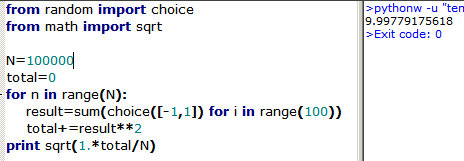Random walks
Richard (aka Bob) is walking on a number line. He begins at 0 , and the i t h step's position, A i , is A i − 1 ± 1 . (Both cases equally probable)
If K is the average value of A 1 0 0 2 , input K .
The answer is 10.
This section requires Javascript.
You are seeing this because something didn't load right. We suggest you, (a) try
refreshing the page, (b) enabling javascript if it is disabled on your browser and,
finally, (c)
loading the
non-javascript version of this page
. We're sorry about the hassle.
3 solutions
This also proves an interesting relation k = 0 ∑ n ( n + k 2 n + 1 ) ( 2 k + 1 ) 2 = 4 n ( 2 n + 1 )
Cool! It's nice to see some confirmation that your ideas actually work :)
I am a scoundrel and a cheater as well.
Python 3.3:
1 2 3 4 5 6 7 8 9 10 11 12 13 14 15 16 17 |
|
Log in to reply
I just input this formula for the Expected value of A_100^2 straight into Wolfram Alpha:
sum(2 (100 choose k) 1/(2^100)*(2(50-k))^2,k=0 to 50)
It yields 100.
Dylan, your method is excellent.
Let's conisider the walk as a vector W = ( x 1 , x 2 , . . . , x 1 0 0 ) , such that x i ∈ { 1 , − 1 } for 1 ≤ i ≤ 1 0 0 . The displacement after 1 0 0 steps is A 1 0 0 = ∣ ∣ ∣ ∣ k = 1 ∑ 1 0 0 x i ∣ ∣ ∣ ∣ . Since 1 0 0 is even, the possible value of the final displacement are A i = 2 n , 0 ≤ n ≤ 5 0 , n ∈ N . Hence,
P ( A 1 0 0 = 0 ) = 2 ⋅ 2 1 0 0 1 ( 5 0 1 0 0 ) P ( A 1 0 0 = 2 ) = 2 ⋅ 2 1 0 0 1 ( 4 9 1 0 0 ) ⋮ P ( A 1 0 0 = 2 n ) = 2 ⋅ 2 1 0 0 1 ( 5 0 − n 1 0 0 )
So, the expected value of the random variable A 1 0 0 2 is
E ( A 1 0 0 2 = 4 n 2 ) = 2 9 9 1 n = 0 ∑ 5 0 4 n 2 ( 5 0 − n 1 0 0 ) = 1 0 0 = K 2
Eventually
K = 1 0

An easy mistake to make in this problem is to find the average value of A 1 0 0 . This is 0, since for any case with a value of n there's equally many cases with a value of − n . This approach is not correct, because while it finds the average the − n cases would actually count as a positive distance and they would not cancel.
Let's find the average value of the distance to 0 squared, A i 2 . Suppose the amount we add for step n is B n , which becomes 0 if it's past i . The overlines represent average values. A i 2 = ( B 1 + B 2 . . . + B i ) 2 A i 2 = ( B 1 2 + B 2 2 . . . + B i 2 ) + m = n ∑ B m B n
We know for each m , n that B m B n = 0 since it's equally probable for their product to be − 1 or 1 . We're left with
A i 2 = ( B 1 2 + B 2 2 . . . + B i 2 ) = i
From this ∣ A i ∣ can be expected to be about i .